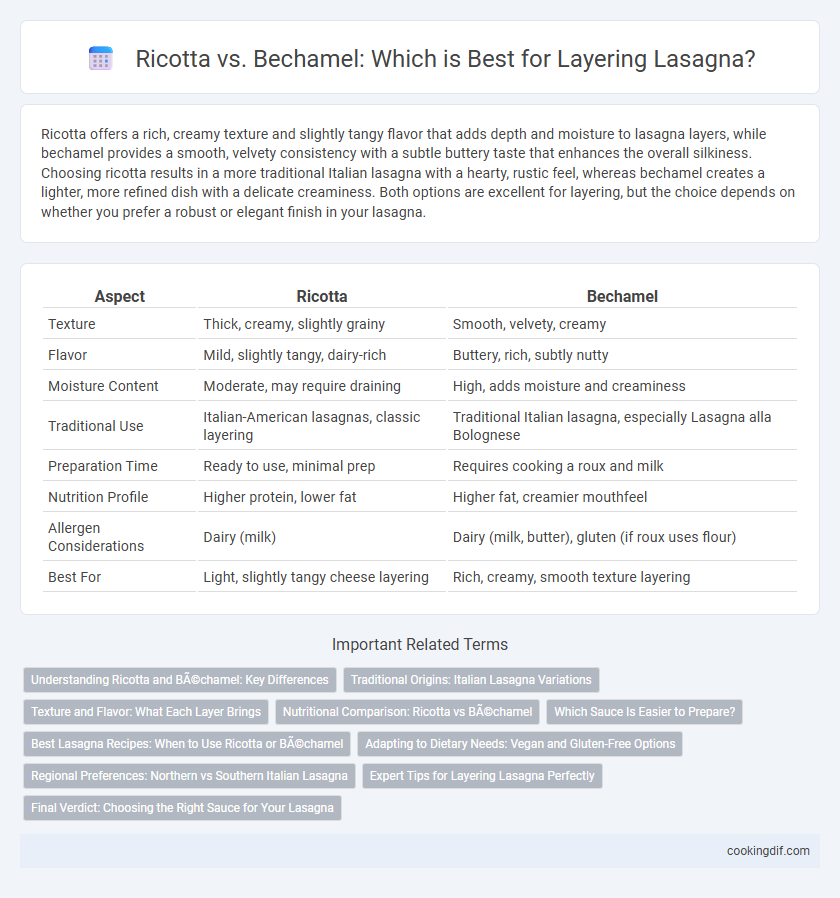Ricotta offers a rich, creamy texture and slightly tangy flavor that adds depth and moisture to lasagna layers, while bechamel provides a smooth, velvety consistency with a subtle buttery taste that enhances the overall silkiness. Choosing ricotta results in a more traditional Italian lasagna with a hearty, rustic feel, whereas bechamel creates a lighter, more refined dish with a delicate creaminess. Both options are excellent for layering, but the choice depends on whether you prefer a robust or elegant finish in your lasagna.
Table of Comparison
| Aspect | Ricotta | Bechamel |
|---|---|---|
| Texture | Thick, creamy, slightly grainy | Smooth, velvety, creamy |
| Flavor | Mild, slightly tangy, dairy-rich | Buttery, rich, subtly nutty |
| Moisture Content | Moderate, may require draining | High, adds moisture and creaminess |
| Traditional Use | Italian-American lasagnas, classic layering | Traditional Italian lasagna, especially Lasagna alla Bolognese |
| Preparation Time | Ready to use, minimal prep | Requires cooking a roux and milk |
| Nutrition Profile | Higher protein, lower fat | Higher fat, creamier mouthfeel |
| Allergen Considerations | Dairy (milk) | Dairy (milk, butter), gluten (if roux uses flour) |
| Best For | Light, slightly tangy cheese layering | Rich, creamy, smooth texture layering |
Understanding Ricotta and Béchamel: Key Differences
Ricotta offers a creamy, slightly grainy texture with a mild, tangy flavor that enhances the richness of lasagna layers, while bechamel provides a smooth, velvety consistency with a subtle buttery taste that adds moisture and delicate creaminess. Ricotta's protein content contributes a hearty structure ideal for combining with spinach or herbs, whereas bechamel's milk and butter base creates a luscious sauce that prevents dryness and binds ingredients seamlessly. Choosing between ricotta and bechamel affects the lasagna's texture and flavor profile, with ricotta imparting a rustic, dense quality and bechamel delivering a silky, refined finish.
Traditional Origins: Italian Lasagna Variations
Italian lasagna variations reflect regional preferences in layering with ricotta or bechamel, each linked to distinct traditional origins. Ricotta is commonly used in southern Italy, particularly in Neapolitan lasagna, offering a creamy texture and mild flavor that pairs well with tomato-based ragu. In contrast, northern Italian recipes, such as those from Emilia-Romagna, favor bechamel sauce, contributing a silky richness that complements rich meat sauces and Parmigiano-Reggiano, highlighting regional dairy production and culinary heritage.
Texture and Flavor: What Each Layer Brings
Ricotta cheese provides a creamy, slightly grainy texture with a mild, tangy flavor that balances rich tomato sauces in lasagna layers. Bechamel sauce adds a smooth, velvety consistency and a subtle buttery taste that creates a richer, more luxurious mouthfeel. Choosing ricotta emphasizes a rustic, hearty texture, while bechamel offers a delicate silkiness that enhances the overall harmony of flavors.
Nutritional Comparison: Ricotta vs Béchamel
Ricotta cheese offers higher protein content and calcium compared to bechamel sauce, making it a nutrient-dense option for lasagna layers. Bechamel, primarily made of butter, flour, and milk, tends to have more calories and saturated fat due to its butter content. Choosing ricotta can enhance the dish's nutritional profile by adding essential amino acids and calcium while keeping fat levels moderate.
Which Sauce Is Easier to Prepare?
Ricotta cheese offers a simpler, no-cook option for layering in lasagna, requiring only mixing with eggs and seasonings before spreading. Bechamel sauce demands more attention, as it involves cooking a roux of butter and flour followed by slow whisking in warm milk to achieve the perfect creamy texture. For home cooks prioritizing ease and speed, ricotta is the more convenient choice, while bechamel requires extra steps but yields a smoother, silkier finish.
Best Lasagna Recipes: When to Use Ricotta or Béchamel
Ricotta provides a creamy, slightly tangy texture that enriches traditional Italian lasagna layers, especially in recipes from Southern Italy, while bechamel sauce offers a smooth, velvety consistency favored in Northern Italian versions like Lasagna alla Bolognese. Ricotta is best used when a richer, more textured filling is desired, complementing robust tomato sauces and hearty meat. Bechamel works well in lasagna recipes that require a lighter, silkier layer, balancing savory bechamel with subtle nutmeg flavor to achieve a delicate and creamy finish.
Adapting to Dietary Needs: Vegan and Gluten-Free Options
Ricotta cheese offers a creamy texture and rich flavor ideal for traditional lasagna, while bechamel provides a smooth, velvety consistency with a lighter taste, perfect for balancing rich tomato sauces. For vegan lasagna, plant-based ricotta alternatives made from tofu or cashews replicate the creaminess without dairy, while bechamel can be adapted using plant-based milk and gluten-free flour to accommodate lactose intolerance and gluten sensitivity. These substitutions ensure flavorful layering while meeting dietary preferences and restrictions in gluten-free and vegan recipes.
Regional Preferences: Northern vs Southern Italian Lasagna
Northern Italian lasagna typically features bechamel sauce, adding a creamy, smooth texture that complements rich meat ragu and Parmesan cheese. In contrast, Southern Italian lasagna favors ricotta cheese, lending a lighter, slightly grainy texture that balances robust tomato-based sauces and mozzarella. These regional preferences highlight the distinct culinary traditions shaping lasagna's layered flavors across Italy.
Expert Tips for Layering Lasagna Perfectly
Choose ricotta cheese for a creamy texture and rich flavor that holds its shape between pasta layers, offering a traditional Italian lasagna experience. Bechamel sauce provides a smooth, velvety consistency that enhances moisture and creates an elegant, uniform creaminess across each layer. Expert chefs recommend balancing ricotta's density with bechamel's silkiness for perfectly structured lasagna that melts harmoniously in every bite.
Final Verdict: Choosing the Right Sauce for Your Lasagna
Ricotta cheese offers a rich, creamy texture and slightly tangy flavor that enhances the layers of lasagna, providing a traditional Italian touch. Bechamel sauce delivers a smooth, velvety consistency with a subtle buttery taste, creating a lighter and silkier layer that balances robust meat and tomato sauces. For a classic, hearty lasagna, ricotta is ideal, while bechamel works best for a delicate, refined presentation with a creamy mouthfeel.
Ricotta vs béchamel for layering Infographic

 cookingdif.com
cookingdif.com